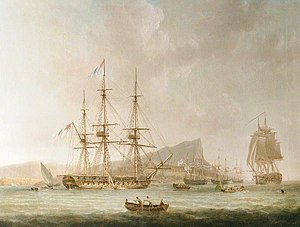 La Sybil, at anchor off Gibraltar, by Anton Schranz
| |
| History | |
|---|---|
| Name | Sibylle |
| Namesake | Sybil |
| Builder | Toulon |
| Laid down | April 1790 |
| Launched | 30 August 1791[1] |
| In service | May 1792 |
| Captured | 17 June 1794 |
| Name | Sybille[2] |
| Acquired | 17 June 1794 |
| Decommissioned | 1833 |
| Honours and awards | Naval General Service Medal with clasp "Sybille 28 Feby. 1799"[3] |
| Fate | Sold 7 August 1833 |
| General characteristics | |
| Class and type | Hébé-class frigate |
| Displacement | 700 tonnes |
| Length | 46.3 m (152 ft) |
| Beam | 11.9 m (39 ft) |
| Draught | 5.5 m (18 ft) |
| Complement | 297 |
| Armament |
|
Sibylle was a 38-gun Hébé-class frigate of the French Navy. She was launched in 1791 at the dockyards in Toulon and placed in service in 1792. After the 50-gun fourth rate HMS Romney captured her in 1794, the British took her into service as HMS Sybille.[a] She served in the Royal Navy until disposed of in 1833. While in British service, Sybille participated in three notable single-ship actions, in each case capturing a French vessel. On anti-slavery duties off West Africa from July 1827 to June 1830, Sybille captured many slavers and freed some 3,500 slaves. She was finally sold in 1833 in Portsmouth.
- ^ Roche (2005), p. 182.
- ^ "No. 20939". The London Gazette. 26 January 1849. p. 239.
Cite error: There are <ref group=lower-alpha> tags or {{efn}} templates on this page, but the references will not show without a {{reflist|group=lower-alpha}} template or {{notelist}} template (see the help page).